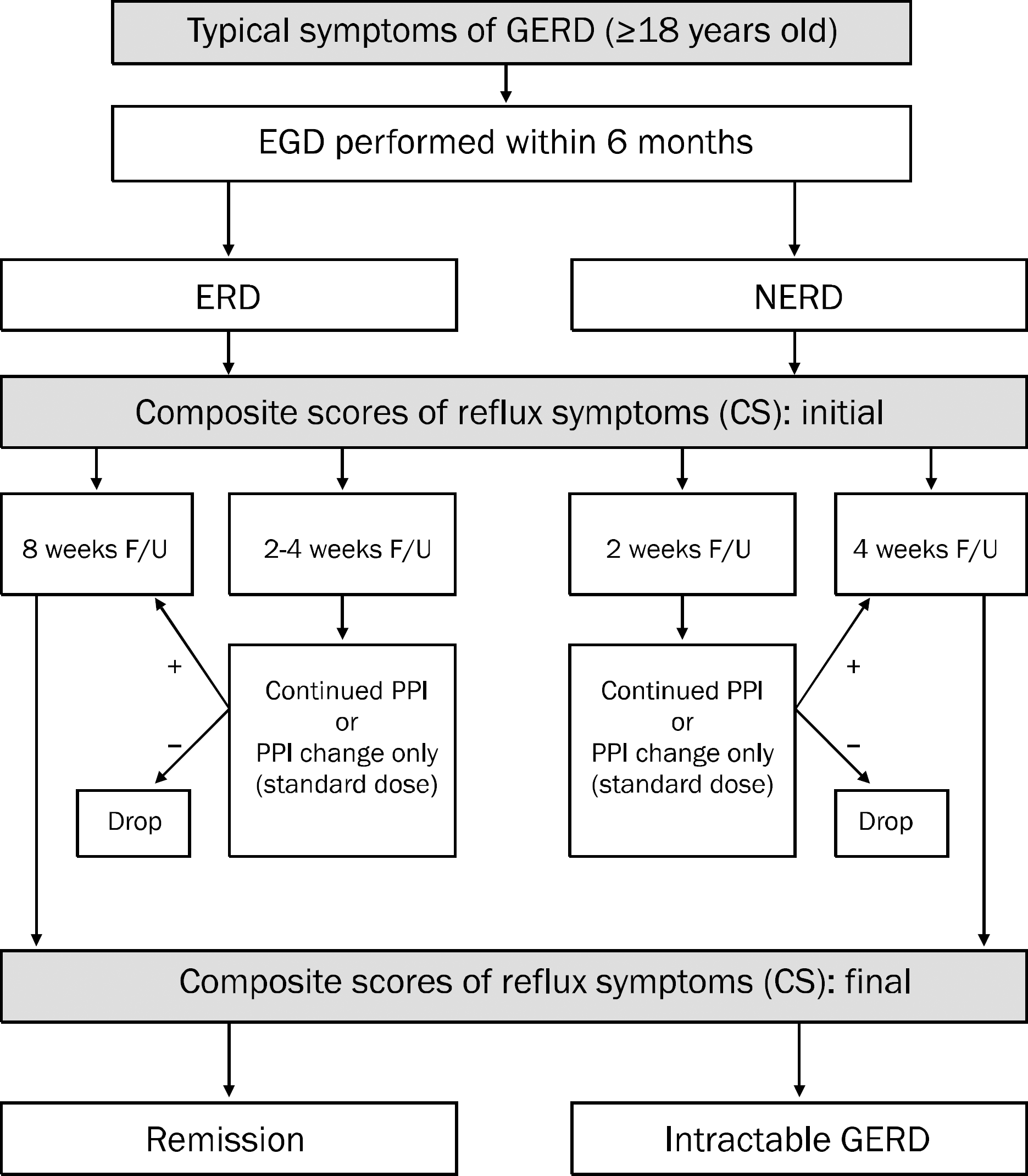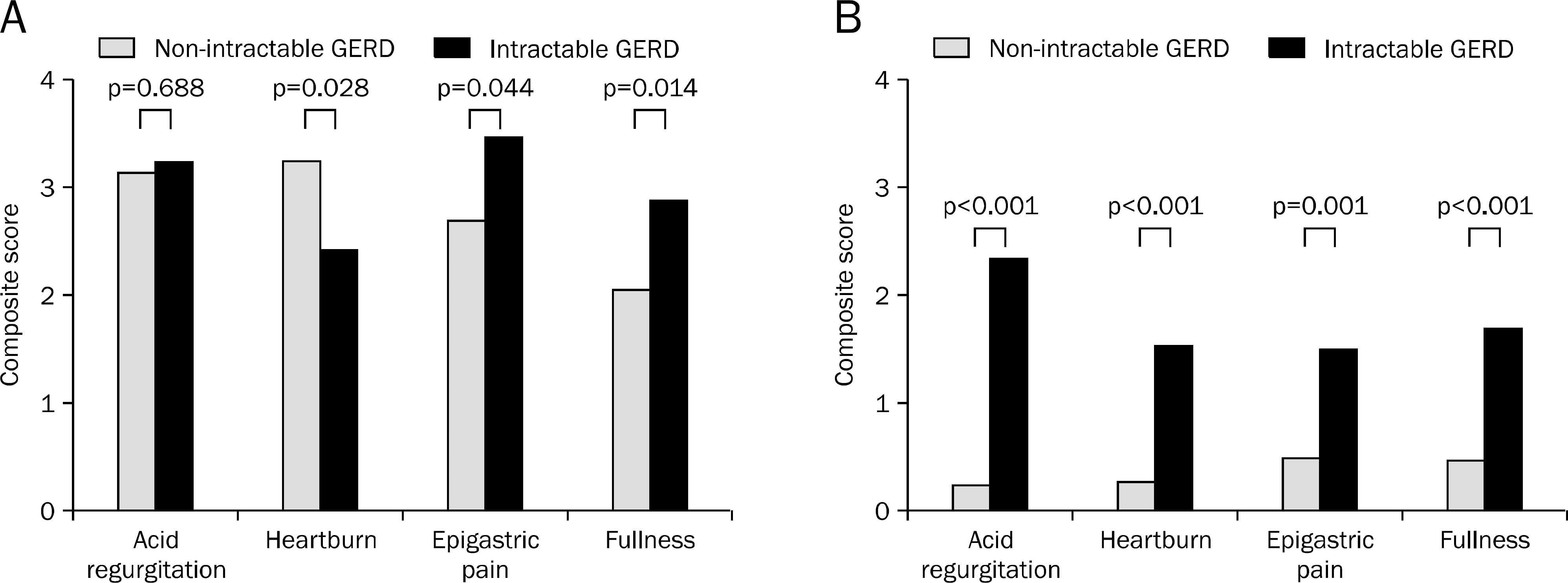Abstract
Background/Aims
In Korea, there are no available multicenter data concerning the prevalence of or diagnostic approaches for non-responsive gastroesophageal reflux disease (GERD) which does not respond to practical dose of proton pump inhibitor (PPI) in Korea. The purpose of this study is to evaluate the prevalence and the symptom pattern of non-responsive GERD.
Methods
A total of 12 hospitals who were members of a Korean GERD research group joined this study. We used the composite score (CS) as a reflux symptom scale which is a standardized questionnaire based on the frequency and severity of typical symptoms of GERD. We defined "non-responsive GERD" as follows: a subject with the erosive reflux disease (ERD) whose CS was not decreased by at least 50% after standard-dose PPIs for 8 weeks or a subject with non-erosive reflux disease (NERD) whose CS was not decreased by at least 50% after half-dose PPIs for 4 weeks.
Results
A total of 234 subjects were analyzed. Among them, 87 and 147 were confirmed to have ERD and NERD, respectively. The prevalence of non-responsive GERD was 26.9% (63/234). The rates of non-responsive GERD were not different between the ERD and NERD groups (25.3% vs. 27.9%, respectively, p=0.664). There were no differences between the non-responsive GERD and responsive GERD groups for sex (p=0.659), age (p=0.134), or BMI (p=0.209). However, the initial CS for epigastric pain and fullness were higher in the non-responsive GERD group (p=0.044, p=0.014, respectively).
Go to : 
References
1. Vakil N, van Zanten SV, Kahrilas P, Dent J, Jones R. Global Consensus Group. The montreal definition and classification of gastroesophageal reflux disease: a global evidence-based consensus. Am J Gastroenterol. 2006; 101:1900–1920.

2. Dent J, El-Serag HB, Wallander MA, Johansson S. Epidemiology of gastro-oesophageal reflux disease: a systematic review. Gut. 2005; 54:710–717.

3. Fock KM, Talley NJ, Fass R, et al. Asia-Pacific consensus on the management of gastroesophageal reflux disease: update. J Gastroenterol Hepatol. 2008; 23:8–22.

4. van Pinxteren B, Sigterman KE, Bonis P, Lau J, Numans ME. Short-term treatment with proton pump inhibitors, H2-receptor antagonists and prokinetics for gastro-oesophageal reflux disease-like symptoms and endoscopy negative reflux disease. Cochrane Database Syst Rev. 2010; (11):CD002095.

5. Moraes-Filho JP, Navarro-Rodriguez T, Barbuti R, Eisig J, Chinzon D, Bernardo W. Brazilian Gerd Consensus Group. Guidelines for the diagnosis and management of gastroesophageal reflux disease: an evidence-based consensus. Arq Gastroenterol. 2010; 47:99–115.

6. Richter JE. How to manage refractory GERD. Nat Clin Pract Gastroenterol Hepatol. 2007; 4:658–664.

7. Bashashati M, Hejazi RA, Andrews CN, Storr MA. Gastroesophageal reflux symptoms not responding to proton pump inhibitor: GERD, NERD, NARD, esophageal hypersensitivity or dyspepsia? Can J Gastroenterol Hepatol. 2014; 28:335–341.

8. Hershcovici T, Fass R. An algorithm for diagnosis and treatment of refractory GERD. Best Pract Res Clin Gastroenterol. 2010; 24:923–936.

9. Kahrilas PJ, Shaheen NJ, Vaezi MF, et al. American gastroenterological association medical position statement on the management of gastroesophageal reflux disease. Gastroenterology. 2008; 135:1383–1391.

10. Fass R, Sampliner RE. Barrett's oesophagus: optimal strategies for prevention and treatment. Drugs. 2003; 63:555–564.
11. Wang JH, Luo JY, Dong L, Gong J, Zuo AL. Composite score of reflux symptoms in diagnosis of gastroesophageal reflux disease. World J Gastroenterol. 2004; 10:3332–3335.

12. Yang SY, Lee OY, Bak YT, et al. Prevalence of gastroesophageal reflux disease symptoms and uninvestigated dyspepsia in Korea: a population-based study. Dig Dis Sci. 2008; 53:188–193.

13. Lee SY, Lee KJ, Kim SJ, Cho SW. Prevalence and risk factors for overlaps between gastroesophageal reflux disease, dyspepsia, and irritable bowel syndrome: a population-based study. Digestion. 2009; 79:196–201.

14. Lee ES, Kim N, Lee SH, et al. Comparison of risk factors and clinical responses to proton pump inhibitors in patients with erosive oesophagitis and non-erosive reflux disease. Aliment Pharmacol Ther. 2009; 30:154–164.

15. Kim SE, Kim N, Oh S, et al. Predictive factors of response to proton pump inhibitors in Korean patients with gastroesophageal reflux disease. J Neurogastroenterol Motil. 2015; 21:69–77.

16. Fass R. Symptom assessment tools for gastroesophageal reflux disease (GERD) treatment. J Clin Gastroenterol. 2007; 41:437–444.

17. Lee D, Lee KJ, Kim KM, Lim SK. Prevalence of asymptomatic erosive esophagitis and factors associated with symptom presentation of erosive esophagitis. Scand J Gastroenterol. 2013; 48:906–912.

18. Goh KL, Choi MG, Hsu WP, et al. Unmet treatment needs of gastroesophageal reflux disease in Asia: gastroesophageal reflux disease in Asia Pacific survey. J Gastroenterol Hepatol. 2014; 29:1969–1975.

19. Oh JH, Choi MG, Kim HR, et al. Clinical spectrum of endoscopic reflux esophagitis in routine check-up subjects in Korea. Korean J Neurogastroenterol Motil. 2006; 12:12–18.
20. Neumann H, Monkemuller K, Kandulski A, Malfertheiner P. Dyspepsia and IBS symptoms in patients with NERD, ERD and Barrett's esophagus. Dig Dis. 2008; 26:243–247.
Go to : 
 | Fig. 1.Diagram of study process. GERD, gastroesophgeal reflux disease; ERD, erosive reflux disease; NERD, non-erosive reflux disease; F/U, follow up. |
 | Fig. 2.Composite scores between intractable gastroesophgeal reflux disease (GERD) and non-intractable GERD. (A) Initial score. (B) Final score. |
Table 1.
Characteristics of Subjects
Table 2.
Initial and Final Composite Scores in Both Groups




 PDF
PDF ePub
ePub Citation
Citation Print
Print


 XML Download
XML Download